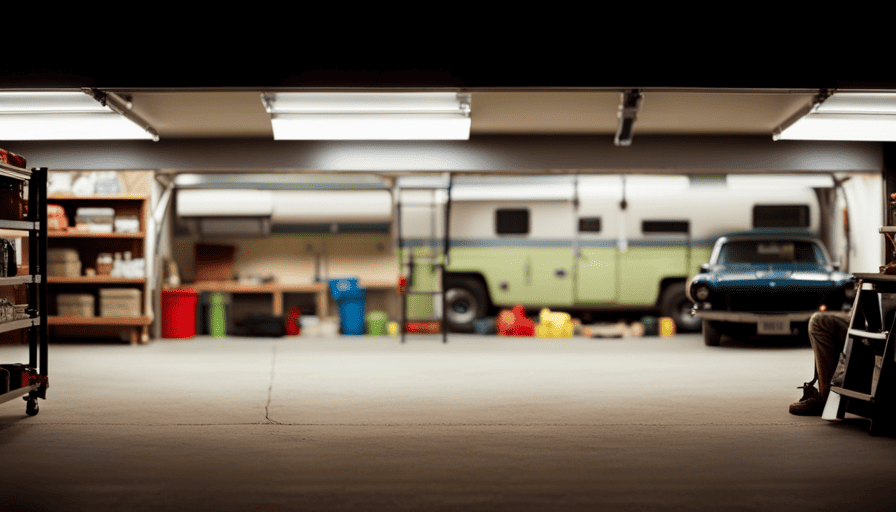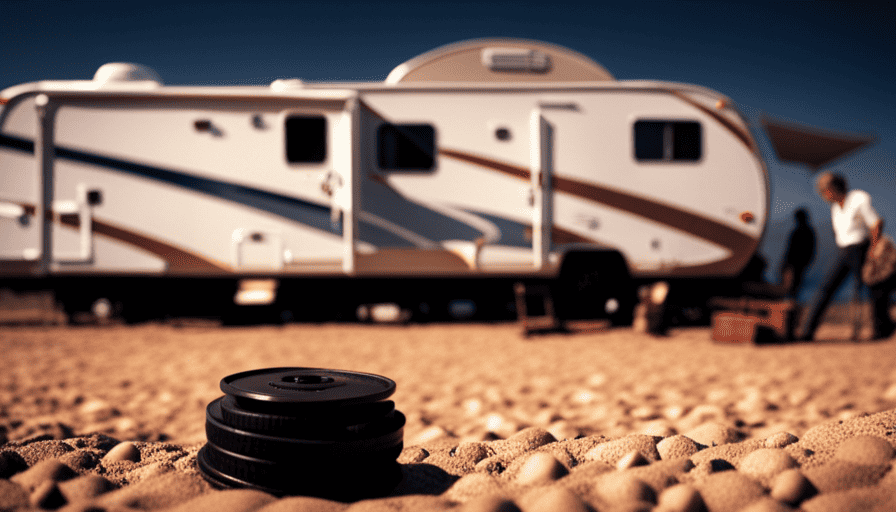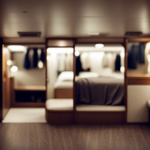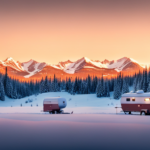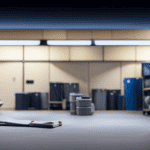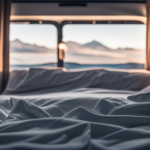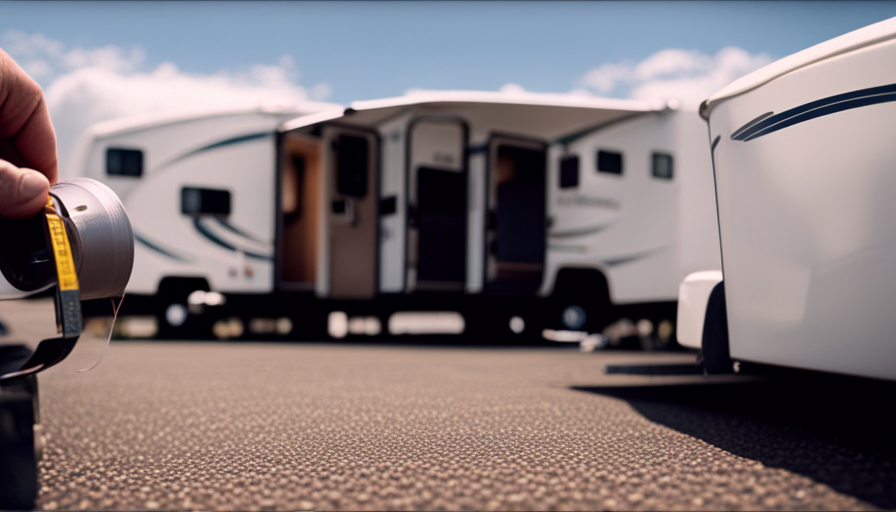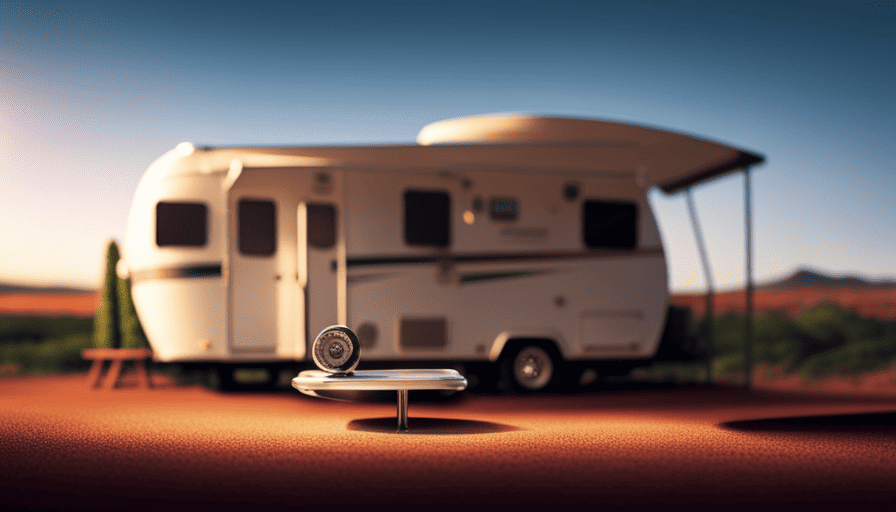Get ready to explore a detailed guide on **camper storage techniques**! Discover expert tips and secrets for keeping your camper organized and clutter-free. Whether you’re a seasoned camper or just getting started, this guide is perfect for anyone looking to maximize space and minimize chaos. Keep reading to revolutionize the way you store your camper gear!
Just like a well-crafted story, storing a camper requires careful planning and attention to detail. Whether you’re a seasoned traveler or a novice adventurer, proper camper storage is essential to ensure its longevity and functionality.
Think of your camper as a cherished book that needs to be carefully shelved, protected from the elements, and preserved for future enjoyment.
In this article, we will walk you through each step of the storage process, from cleaning and preparing the camper to preventing pest infestations. We’ll also share tips on maintaining proper ventilation, checking tires, and regularly inspecting your camper during its time in storage.
So, let’s dive in and learn how to store your camper like a pro!
Key Takeaways
- Proper cleaning and preparation are essential for storing a camper
- Choose a secure and climate-controlled storage location
- Drain water systems and remove batteries before storage
- Use a waterproof and breathable cover to protect the camper from moisture and mold
Clean and Prepare the Camper for Storage
Now, it’s time to clean and get our camper ready for storage. First, gather all the necessary cleaning supplies. You’ll need a broom, vacuum cleaner, all-purpose cleaner, window cleaner, and microfiber cloths.
Start by removing all the items from the camper, including bedding, curtains, and cushions. Give everything a good shake to remove any dirt or dust. Then, use the vacuum cleaner to thoroughly clean the floors, corners, and hard-to-reach areas.
Next, wipe down all the surfaces with the all-purpose cleaner. Make sure to clean the countertops, cabinets, and tables. Don’t forget to clean the windows using the window cleaner and a microfiber cloth for a streak-free shine. Pay extra attention to the bathroom and kitchen areas, as they tend to accumulate more grime.
Once the camper is clean, it’s time to organize the storage. Group similar items together and label them accordingly. Utilize storage bins or boxes to keep everything organized and easily accessible. Consider using vacuum-sealed bags for bedding and clothing to save space. When arranging everything back into the camper, make sure to distribute the weight evenly to prevent any damage.
Now that the camper is clean and organized, it’s time to choose a suitable storage location.
Choose a Suitable Storage Location
Ideally, you’d want to find a spot that’s secure, easily accessible, and protected from the elements, like a covered carport or a spacious garage. When searching for suitable storage facilities, consider the following factors.
First, ensure that the location provides adequate security measures such as surveillance cameras, gated access, and on-site staff. This will give you peace of mind knowing that your camper is protected from theft or vandalism.
Additionally, look for storage facilities that offer climate control options. Extreme temperatures can damage the interior of your camper, causing mold, mildew, or even cracking of materials. Climate-controlled storage will maintain a consistent temperature and humidity level, preserving the condition of your camper.
When storing your camper, it’s crucial to empty and defrost the refrigerator. Leftover food can attract pests and create unpleasant odors. Start by removing all items from the refrigerator and freezer compartments. Dispose of any perishable items and clean the interior thoroughly with mild soap and water. Don’t forget to defrost the freezer to prevent ice buildup. Once the refrigerator is clean and dry, prop the doors open slightly to allow for airflow and prevent any lingering odors.
Taking these steps will ensure that your camper is properly prepared for storage and ready to be used again when the time comes.
Empty and Defrost the Refrigerator
Choose a suitable storage location for your camper that has a refrigerator, and make sure to empty and defrost it before storing it. This step is crucial to ensure the longevity and proper functioning of your refrigerator.
Start by removing all the food and beverages from the refrigerator. Dispose of any perishable items properly to avoid any unpleasant odors or mold growth.
Next, unplug the refrigerator and allow it to defrost naturally. To speed up the process, you can place towels on the bottom of the fridge to absorb the melting ice. Once the ice has melted, remove the towels and wipe down the interior with a mixture of warm water and mild detergent. Make sure to clean all the shelves, drawers, and seals thoroughly. Don’t forget to remove any detachable parts and clean them separately.
Afterward, rinse with clean water and dry everything completely. Lastly, leave the refrigerator door slightly open to prevent any musty smells from developing.
With the cleaning supplies and refrigerator maintenance completed, it’s time to move on to draining the water systems.
Drain the Water Systems
To ensure the proper maintenance of your refrigerator, it’s time to drain the water systems in your camper. This is an essential step in winterizing your camper and preventing any damage that might be caused by freezing temperatures.
Before you begin, make sure you have all the necessary tools and equipment, such as a water pump, a bucket, and a hose.
Start by turning off the water supply to your camper. This may involve shutting off the main water valve or disconnecting the water hose if you’re connected to a water source.
Next, open all the faucets, including the hot and cold water taps, and let the water drain out completely. Don’t forget to flush the toilet and run the shower to ensure all the water is removed from the system.
Once the water has been drained, it’s important to remove any remaining water from the water pump and hot water tank. Refer to your camper’s manual for specific instructions on how to do this, as the process may vary depending on the model.
With the water systems drained, you can now move on to the next step of disconnecting and removing the batteries. This will ensure that your camper is fully prepared for storage during the winter months.
Incorporating these simple steps into your winterization routine will help protect your camper from potential water damage and ensure it’s ready for use when the camping season starts again.
Disconnect and Remove Batteries
After draining the water systems, it’s time to bid farewell to the power source of your camper by disconnecting and removing its batteries. Here are four important steps to ensure proper battery storage:
-
Disconnect the batteries: Start by turning off all power sources, including the main breaker and any solar panels or generators. Then, use a wrench to disconnect the battery cables. Be sure to remove the negative cable first to avoid any accidental sparks or short circuits.
-
Clean the battery terminals: Before storing the batteries, it’s crucial to clean the terminals to prevent corrosion. Mix a solution of baking soda and water, and use a wire brush to scrub away any dirt or buildup. Rinse with clean water and dry thoroughly.
-
Store the batteries in a cool, dry place: Batteries should be stored in a location that is protected from extreme temperatures and moisture. A garage or storage shed is ideal. Make sure the batteries are placed on a stable surface and are not stacked on top of each other.
-
Charge the batteries periodically: To maintain the health of your batteries during storage, it’s recommended to charge them every few months. This will prevent them from completely discharging and prolong their lifespan.
Now that the batteries are properly disconnected and stored, it’s time to move on to the next step: covering the camper for protection.
Cover the Camper for Protection
Once you’ve safeguarded the batteries, it’s time to shield your precious camper from potential damages by securely covering it. A camper cover offers numerous advantages in terms of protection and preservation.
First and foremost, it acts as a shield against the elements, preventing rain, snow, and UV rays from causing any harm. This not only extends the lifespan of your camper but also keeps it looking brand new.
Additionally, a good quality cover can prevent dust, dirt, and debris from accumulating on the exterior, saving you valuable time and effort in cleaning.
Choosing the right camper cover is crucial to ensure maximum protection. Firstly, consider the material. Opt for a cover that’s waterproof, UV resistant, and breathable to prevent moisture build-up and mold growth. Additionally, make sure the cover is designed to fit your camper snugly, providing a secure fit that prevents wind from getting underneath and causing damage.
It’s also important to choose a cover that’s easy to install and remove, as this’ll make your camping experience more convenient.
As we move on to the next section about maintaining proper ventilation, it’s important to note that covering your camper doesn’t mean completely sealing it off. Proper ventilation is essential to prevent condensation and mildew.
Maintain Proper Ventilation
After covering the camper to protect it from the elements, it’s important to ensure proper ventilation to maintain its overall condition. Adequate air circulation is crucial for preventing the buildup of moisture, which can lead to mold, mildew, and other damage.
To achieve proper ventilation, there are a few key steps you can take:
-
Open the camper windows or vents: This allows fresh air to flow in and stale air to exit, promoting air circulation throughout the interior.
-
Use roof vents or fans: These can help increase airflow and prevent condensation by expelling warm, moist air from the camper.
-
Consider using dehumidifiers or moisture absorbers: These devices can help control humidity levels and reduce the risk of moisture-related issues.
-
Regularly check and clean the camper’s air filters: These filters play a crucial role in maintaining good air quality inside the camper and should be cleaned or replaced as needed.
By ensuring proper ventilation, you can effectively control moisture and maintain a healthy environment inside your camper.
Now, let’s move on to the next section and learn how to check and maintain the tires for optimal performance.
Check and Maintain Tires
To ensure optimal performance, we need to regularly check and maintain the tires of our recreational vehicle. Proper tire maintenance is crucial for a smooth and safe journey.
The first step is to monitor the tire pressure regularly. Maintaining the correct tire pressure is essential for both the longevity of the tires and the overall stability of the camper. Low tire pressure can lead to excessive wear and tear, reduced fuel efficiency, and even blowouts while driving. On the other hand, overinflated tires can cause a harsh ride and decrease the vehicle’s handling capabilities. Therefore, it’s important to consult the manufacturer’s guidelines or a tire professional to determine the ideal pressure for your specific camper.
Furthermore, inspecting the tires for any signs of damage such as cracks, bulges, or uneven tread wear is crucial. Replace any damaged tires immediately to prevent accidents on the road.
With proper tire maintenance, you can ensure a safe and smooth journey for yourself and your family. Speaking of safety, let’s now move on to the next section about preventing pest infestation without compromising ventilation.
Prevent Pest Infestation
Don’t let pests ruin your trip – keep your recreational vehicle pest-free by following these simple steps. Preventive measures are key when it comes to keeping pests out of your camper during storage.
Start by thoroughly cleaning your RV before storing it. Remove any food crumbs, spills, or leftovers, as these can attract pests. Seal all openings, such as windows, vents, and doorways, with screens or weather stripping to prevent insects and rodents from entering. Additionally, consider using pest control techniques like sprays or traps to further deter pests.
Regularly check on the camper during storage to ensure that no pests have made their way inside. Inspect the exterior for any signs of damage or entry points that need to be sealed. Take the time to clean the interior as well, removing any potential food sources and checking for any signs of infestation.
By staying proactive and vigilant, you can prevent pests from causing damage to your camper and enjoy a pest-free trip when it’s time to hit the road again.
Regularly Check on the Camper during Storage
Make sure you frequently inspect your recreational vehicle during storage to ensure that no pests have found their way inside. Regularly checking on your camper is essential to prevent any potential damage caused by pests and to maintain its overall condition. Here are some key areas to focus on when inspecting your camper:
-
Inspect interior:
- Start by checking for any signs of droppings, nests, or chewed materials inside your camper. Pests like rodents and insects can cause extensive damage if left unchecked.
- Thoroughly inspect all cabinets, drawers, and storage compartments for any signs of pests. Pay close attention to corners and crevices.
- Check for any holes or gaps in the walls, floors, or ceilings that could serve as entry points for pests. Use sealants or caulk to seal these openings.
-
Check exterior:
- Examine the exterior of your camper for any visible signs of damage, such as holes, cracks, or loose panels. These can provide easy access for pests.
- Inspect all vents, windows, and doors to ensure they’re properly sealed and free from any gaps or tears.
- Clean the exterior thoroughly to remove any dirt or debris that may attract pests.
By regularly inspecting both the interior and exterior of your camper, you can identify and address any potential pest issues before they escalate. This proactive approach will help ensure that your camper remains pest-free and in excellent condition during storage.
Frequently Asked Questions
How often should I check on the camper during storage?
During camper storage, it’s important to regularly check on your camper to ensure its safety and maintenance. We recommend checking on the camper at least once a month.
This will allow you to inspect for any potential issues such as leaks, pests, or damage. Additionally, it’s a good opportunity to clean the interior, check the tires, and ensure all systems are functioning properly.
Regular checking of the camper will help prevent any major problems and ensure it’s ready for your next adventure.
What are some common pests that can infest a camper during storage?
During storage, campers can become infested with common pests such as rodents, ants, spiders, and termites. These pests are attracted to food crumbs, moisture, and dark spaces.
To prevent infestations, it’s important to thoroughly clean the camper before storage, seal any openings, and remove all food sources. Using pest repellents and traps can also be effective.
Regularly checking on the camper and maintaining a clean and dry environment will help ensure a pest-free storage experience.
Should I remove all the food from the refrigerator before storing the camper?
Yes, it’s highly recommended to remove all the food from the refrigerator before storing the camper. This is crucial for proper food storage and refrigerator maintenance. Leaving food in the refrigerator can lead to spoilage, unpleasant odors, and the growth of mold and bacteria. It’s important to thoroughly clean the refrigerator and ensure it’s completely empty before storing the camper to prevent any potential damage or health hazards.
Can I store the camper outside without a cover?
Yes, you can store the camper outside without a cover, but it’s not recommended. Using a cover provides protection against the elements such as rain, snow, and UV rays, which can cause damage to the exterior and interior of the camper. Without a cover, the camper is exposed to potential risks like fading, cracking, and water damage. Therefore, it’s advisable to use a cover to ensure the longevity and preservation of your camper.
Is it necessary to remove the batteries from the camper during storage?
When it comes to camper storage, it’s indeed necessary to remove the batteries. Just like the heart of our trusty camper, these batteries need some TLC during hibernation. By removing them, we ensure their longevity and prevent any potential damage.
Plus, it’s a great opportunity to give them a thorough check-up and recharge if needed. So, remember to take out those batteries and give them the attention they deserve for a smooth and worry-free storage period.
What Are the Average Costs of Storing a Camper?
The cost of camper storage can vary depending on location, size, and duration of storage. On average, monthly rates range from $50 to $200. Outdoor storage tends to be cheaper, while indoor storage offers better protection but comes at a higher cost. Additional fees may apply for amenities like electricity or security measures. Ultimately, factors like convenience and peace of mind influence the total cost.
Is Proper Storage Necessary for Winter Living in a Camper?
Proper storage is crucial for living in camper winter season. Without it, you risk damage to your vehicle and belongings due to harsh weather conditions. Ensuring your camper is properly stored during the winter months will not only protect your investment but also make for a more comfortable living situation when you’re on the road.
Conclusion
In conclusion, storing a camper requires careful preparation and maintenance to ensure its longevity. By following the steps outlined in this article, you can protect your camper from damage and keep it in top condition during storage.
One interesting statistic is that, according to a study by the RV Industry Association, the number of RV households in the United States has reached a record high of almost 11 million. This shows the growing popularity of camping and the importance of properly storing and maintaining campers.
So, whether you’re a seasoned camper or a newbie, remember to take the necessary steps to store your camper correctly and enjoy many more adventures on the road.

